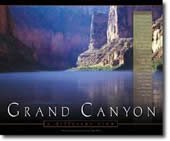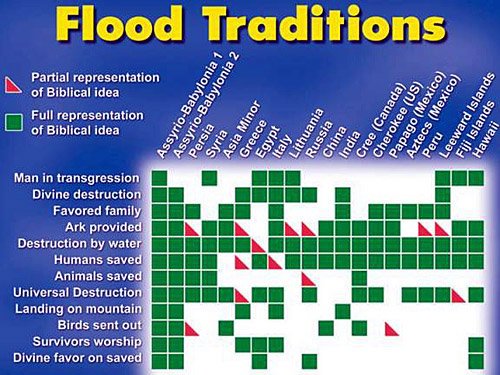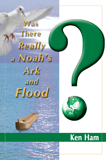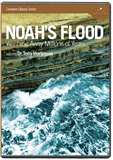Still Searching for the Truth
The accuracies—and inaccuracies—of a recent National Geographic Channel “Search for Noah’s Ark” special
What can science tell us about Noah’s Ark and the Flood? Anything? A recent National Geographic Channel program aimed to find out:
A wicked world. An angry god. A righteous man named Noah who built an Ark, and survived a flood. But did it happen the way the Bible describes it? While some scientists are looking for answers, others search for confirmation on the biblical account. Will they find it? Or, was the story of Noah simply a story? Of God … and man … and a promise?
The story of a man, and a boat, and a flood first appears in the Middle East—the same part of the world that gave birth to Judaism, Christianity, and Islam. It’s told in both the Bible and the Qur’an. The account of a catastrophic event that happened very early in human history, not too long after the creation. Many of us learned the story when we were kids, even if we didn’t go to Sunday School. But how seriously should we take the story of Noah and his Ark? Did it happen the way the Bible tells us it did?
With that intriguing introductory narration, the program embarks on a review of major theories for what caused the Flood, whether the Flood was global or local (or entirely mythical), whether there is geological evidence for the Flood, whether Noah’s Ark could have been built to survive the Flood, and so on. Interviewees range from Tom Vail, a creationist who heads up AiG Grand Canyon raft trips, to Alan Gishlick, a geologist for the staunchly anti-creationist National Center for Science Education.


One of the books referenced in “Search for Noah’s Ark” is Grand Canyon: A Different View, compiled by Grand Canyon raft leader Tom Vail of Canyon Ministries.
The program makes its first mistake early on when the narrator explains that both the Bible and Qur’an contain “the account of a catastrophic even that happened very early in human history—not too long after the creation.” Actually, according to the chronology the Bible presents, the Flood happened over 1,500 years after the creation.
The viewer is then shown a scene less common now than it one day was: a Sunday School classroom full of children learning about Noah and the Ark. After the narrator comments that most of us learned the story as children, he asks, “But how seriously should we take the story of Noah and his Ark? Did it happen the way the Bible tells us it did?
Opposing perspectives come from Bob Cornuke, author of Ark Fever, who believes in the biblical account of the Flood, and George Washington University archaeologist Eric Cline, who doubts that there was a worldwide flood and comments that he “[doesn’t] see any evidence in the geology or anything else for a worldwide catastrophe. Next, Rev. Dr. Francis Wade of Washington DC’s St. Alban’s Episcopal Church explains his compromised view:
I believe the story about the Flood. Now, if you ask me, do I believe that there was a 450-foot-long Ark with all the animals of the earth crammed inside of it … specifically, probably no.
“But Can the Bible Be Taken Literally?”
It is under this narratorial inquiry that the program begins its investigation of the biblical account of Noah. The first question delved into is the ages of people involved in the account.
Pre-Flood Ages
“Noah, for instance, was about 500 years old when he got the warning [of the Flood], and that poses a problem for many modern readers.” The program turns to archaeologist David Merling of Andrews University, who explains that the ages of Noah and other men in Genesis pose an “unusual problem because that’s not what we see today.”
“But it’s not an insoluble problem,” the narrator cautions. Merling suggests that humans may have originally been intended to live longer lives, but that environmental changes may have disrupted the length of human lives.
But the program then turns back to Reverend Wade, who metaphorizes the numbers in Genesis: “When the Bible talks about years, age, it’s talking about respect … it’s a culture in which age was respected. So when you assign more years to a person, you’re talking about the great respect with which they are held.”
Notice the word Reverend Wade uses—assign—to describe the age records in Genesis. According to his view, the numbers in Genesis have no relation to actual data, but are merely ascriptions of respect. But such a hermeneutic creates many problems if it is extended across the Bible; it leads one to doubt many important miracles. If the Bible effectively lies about data presented straightforwardly and without literary decoration, how could we possibly take literally the more extravagant miracles of the Bible? For example, the Bible tells of Elijah ascending to heaven in a chariot of fire. But there is little doubt Reverend Wade considers this a mere figurative description to indicate the respect Elijah carried. And, of course, when one carries this hermeneutic to its consistent logical conclusion, one must ask if Jesus truly rose from the grave, or if this passage was figurative and shows only the great awe and respect early Christians had for Jesus.
Tom Vail, president of Canyon Ministries, compiler of Grand Canyon: A Different View, and leader of Answers in Genesis Grand Canyon raft trips, enters the fray next. “God’s Word can be taken literally ... and in the beginning, ‘God created in six days’ means He created it in six literal, 24-hour days.”
Dating the Flood
The program’s narrator then follows a tangential path, leaving the issue of Noah briefly and instead recounting the chronology work of Archbishop James Ussher (you can read more about Ussher’s work in The World: Born in 4004 BC?), who dated the year of the Flood to 2348 BC. An actor portrays Ussher working on his calculations, but the program soon segues to a three-dimensional rendering of what the Ark may have looked like. The program then reviews the dimensions of the Ark.
One admirable step the program takes is to accurately portray the Ark’s general appearance. Most people inaccurately think of the Ark as a small vessel (due to the influence of so-called “bathtub arks”), but in fact, the Ark was a massive ship, easily able to house the required animals and supplies and remain seaworthy. The program portrays an Ark with appropriate dimensions, claiming that “if the Bible’s dimensions are correct, it would have been the largest wooden vessel in the history of the world—the original man-made wonder.”
Finding the Ark
Next, viewers are whisked away to scenes of Ark-hunting teams exploring the mountains of Ararat. The program takes a tour of the history of Ark-hunting, replaying black-and-white footage of the Russian Revolution while recounting a possible Arkology expedition dispatched by Russian Czar Nicholas II. This history lesson also reviews the advent of the use of aerial and satellite photography in the search for the Ark, then takes its cameras to an interesting site: the Noah’s Ark National Park Visitors Center, near one of the alleged Ark remains. Haji Hassan Bey of the Noah’s Ark National Park Museum, who describes himself (through a translator) as “the historian of Noah’s Ark,” is adamant that the the Ark is at his site. Dr. Farouk El-Baz, a Boston University geologist, recounts the efforts of James Irwin, Ark-hunting astronaut and author of Destination: Moon. The program next turns to Professor Porcher Taylor of the University of Richmond, who discusses the use of satellite imagery in Ark-hunting—from the Ararat anomaly onward.
The Ark-hunting field is understandably exciting, but has resulted in numerous “false” discoveries. The problem comes when people base their belief about the Flood (and its representation of the coming judgment) on archaeological discoveries instead of the Word of God.
Ark Construction—Feasible?
After reviewing the history of Ark-hunting, the program backs up, asking, “But are the Ark-hunters combing the mountains for a boat that might not even exist? Could Noah have really built a boat that big? Some modern shipbuilding experts have their doubts … .”
“Noah’s project is pretty unbelievable, as far as the size of 450 feet dimensions and 75 feet wide. Being a boatbuilder, that would be a glacial task,” laughs Peter Johnson, a Boothbay Harbor (Maine, USA) shipwright. The narrator jumps in, explaining that a twelve-man crew at Boothbay Harbor takes about a year to build a 60-foot-long wooden boat. Marine architect David Stimson suggests that Noah “wouldn’t have been steam-bending wood,” and instead would have used edge-cutting tools to shape pieces for the Ark’s hall. The narrator is quick to point out that Noah’s tools would have most likely been made of stone. But the Bible implies the opposite. In Genesis 4:22, Tubal-Cain, son of Lamech, is said to have “forged all kinds of tools out of bronze and iron”; because Tubal-Cain lived before the Flood, Noah would have probably used metal tools.
The narrator continues:
It’s clear that Noah would have faced a number of challenges. The mysterious gopher wood Noah used would have had to have been super-strong, though some fundamentalists believe Noah could have solved the problem by building a vessel that was shaped more like a barge than a boat. But the question is, could such a gigantic vessel have survived a mighty storm and a flood?
Shipwright Peter Johnson jumps back in while images of storms and raging water roll across the screen. “In big seas a big boat gets working and twisting and it can break in half. Noah’s boat could have withstood a moderate storm. I wouldn’t say it would survive a catastrophic storm—boats can’t even survive those now.” Yet standing opposed to Johnson’s view are nine scientists from the Korea Research Institute of Ships and Engineering. Read their conclusions in Safety Investigation of Noah’s Ark in a Seaway.
“What Were Those Waters?”
The program then turns to looking for evidence of a global flood: “Whether the Ark of Noah existed or not, some people think there are clues that point to a global flood,” leads the narrator. Dr. Bruce Masse, an archaeologist with the Los Alamos National Laboratory, states, “Every culture worldwide has a Flood myth. It’s probably the only truly universal myth that we have.”

For more on the many Flood “myths” worldwide, see Flood Legends
The program then refers to the Epic of Gilgamesh, and Dr. Cline lists some of the similarities between the Gilgamesh Epic and the Genesis Flood account. Cline concludes that “there are enough similarities between the story in the Bible of Noah’s Ark and the story in the Epic of Gilgamesh that, without a doubt, they are related.” We certainly agree; the similarities between the many Flood accounts clearly indicate a universal origin. The question is, which is the true account of the Flood, and what explains the fact that cultures on different continents all have such alarmingly similar Flood stories? Also, read about the similarities between the Flood accounts in the Gilgamesh Epic and Genesis—and which came first—in Introduction.
Where did the waters come from? The program tackles this question next. First, it reviews the idea that the “fountains of the deep” were geysers releasing trapped subterranean water. “It’s not a theory mainstream geologists take seriously,” the narrator cautions, and turns it over to Dr. Alan Gishlick, a geologist with the National Center for Science Education. “You don’t have to really propose what might happen if water came up from below because we just know there’s no water down there,” explains Gishlick, who obviously ignores the possibility that subterranean water released during the Flood might have settled in ocean basins rather than returning underground. “If all the geysers erupt globally, you wouldn’t really put that much water up into the planet to do anything, but it might be kinda cool standing around in Yellowstone waiting for geysers to go off,” continues Gishlick. Again, Gishlick assumes that conditions now reflect pre-Flood conditions, and presupposes that the relative lack of subterranean water now means there never could have been more underground water. This method of presupposing that the present is the key to the past is the basis of uniformitarianism.
The next theory the program deals with is canopy theory, first proposed by Henry Morris and John Whitcomb. Canopy theory postulates that a large amount of water vapor existed in the pre-Flood atmosphere, extending far above the surface of the earth. (Answers in Genesis recommends against the use of canopy theory, as it is an extrascriptural concept that has never been fully perfected—though a partial canopy may have been present before the Flood.) Dr. Gishlick argues against canopy theory in the program, accurately explaining that “it really wouldn’t be a pleasant place to live, because it would be like sitting at the bottom of the deepest trench on [sic] the ocean.” The narrator brings viewers’ attention to Venus, whose vapor canopy generates crushing pressure at the planet’s surface.
The program then turns back to Dr. Masee, who has a different idea about the origin of the Floodwaters: a cometary collision. “Many different [Native American] cultures that relate to the Flood, usually it’s in association with water serpents, feathered-headdress serpents,” explains Masee. “When you look at comets, you see the tails—what looks like a headdress, or a horn. Based on the mythology, it’s very clear to me that we are looking at a comet hitting the ocean somewhere as the basis for the Great Flood.” (Masee is not the only scientist to propose such an idea.)
The program’s narrator enthusiastically explains that the scenario is “not that far-fetched,” and calls upon Dr. El-Baz, who claims the model “is actually the most plausible of all theories [of Floodwater origins].” (The program also sneaks in a reference to a meteorite impact “probably” killing off the dinosaurs 65 million years ago.) For an in-depth look at the origin of the Floodwaters, see Was There Really a Noah’s Ark & Flood?
Is There Any Geological Evidence of the Flood?
“A flood that covered the whole earth: that’s what the Bible tells us in the story of Noah. But most geologists can’t find any evidence to support such a theory,” voices the narrator, while video of Dr. Gishlick poring over Grand Canyon rocks is shown. Dr. Gishlick claims “we really don’t know if there’s been any point in the earth’s history where the planet was completely covered by water.”
Yet the narrator quickly overturns geologist Gishlick’s claims. “Conventional geology does assert that the earth was almost entirely covered by water about 500 million years ago, when the climate was much warmer than it is now. That’s when many of the marine fossils we find on mountaintops today were deposited. At least, that’s what most geologists believe. But not those who regard the Bible as the supreme authority.”
The program then turns again to Tom Vail, airing video of his rafting trips and recording some of Vail’s experience at the canyon. “To Vail,” the narrator begins, “the Grand Canyon is a laboratory that proves the earth was created in the last few thousand years, and then blanketed by a worldwide flood. And the evidence is in the rocks.” Vail is shown near a bent section of Tapeats Sandstone, explaining how the intact-but-folded layers are a sign that the sandstone was wet and malleable when originally deposited—evidence for a catastrophic flood, not for slow deposition over millions of years.
Dr. Alan Gishlick counterargues that the large U-shaped bends in the canyon argue against its rapid formation. But canyons with similar twists and bends are known to have formed rapidly. For instance, the canyon drainage basin of the Toutle River, which is up to 140 ft (43 m) deep in places, was cut in a single day (March 19, 1982) by a flash mudflow.
Mr. Vail then points out that the distribution of fossils in the Grand Canyon is not uniform, and that marine fossils (considered extremely old by evolutionists) are found throughout the layers. Dr. Gishlick responds that if a catastrophe caused the fossil layers, one would expect absolutely no organization in the layers—that is, uniformly distributed fossils. But the model that best explains both the organization that we find and the frequent disorganization (finding fossils in the “wrong” stratum, finding polystrate fossils, etc.) is the ecological view of the geologic column.
But Dr. Cline jumps back into the program, ridiculing the creationist view by claiming that the Bible is “not a history book … it’s not a geology textbook.” Of course, regardless of whether one agrees with it, the Bible is very much a history book in many regards (though not all parts of the Bible are historical narratives, of course). Furthermore, although the Bible is certainly not a geology textbook, this does not mean the Bible has no connection to geology; instead, it means that, although the Bible may not detail exactly how a worldwide Flood caused the geology we see today, it still clearly states that a worldwide Flood occurred—a Flood which, science tells us, would have catastrophic geological implications.
Finally, Rev. Dr. Wade appears once again to similarly discredit the Bible: “The Bible is like a person, and if you torture it long enough, you can get it to say almost anything you’d like it to say. But it’s not a science book.” One wonders how a reverend such as Dr. Wade builds a theology if he believes the Bible can say anything—and, thus, really says nothing.
The program returns to Bob Cornuke and his search for the Ark, who calls the Ark an “unprovable hypothesis,” since “Noah didn’t leave his fingerprints.” Indeed, it would be difficult to “prove” the story of the Flood from an archaeological perspective without finding the Ark—hence the problem of basing one’s ideas about the Bible on what science can uncover. However, Cornuke has made some interesting finds, including partially unfossilized clams on top of the mountains of Ararat. Dr. El-Baz claims there’s nothing peculiar about “finding a little shell on top of a mountain,” but offers no explanation for how the clams actually got there.
“But There’s one Final Theory to Explore—and it Might Be the Most Reasonable of All”?
In the program’s final segment, we meet geologist Drs. Bill Ryan and Walter Pitman of the Columbia Earth Institute, who are busy proposing another theory as to the origin of the Flood accounts: a sudden overflow of the Black Sea. While mapping the Black Sea, the two discovered underwater beaches—a sign that the sea level had risen catastrophically in the past. Core samples from the floor of the Black Sea indicate that “marine mollusks all seem to have appeared at all depths in the Black Sea at the same time—7,600 years ago, so something big had happened there,” explains Dr. Ryan. The narrator explains the theory further: global warming ended an ice age, melting polar and glacial ice and flooding the Mediterranean Sea (and other bodies of water), which overflowed into the Black Sea via the Dardanelles and the Bosporus in about “thirty to ninety days.”
Dr. Fred Hiebert, a National Geographic Archaeology Fellow, suggests that the land around the pre-catastrophe Black Sea would have been occupied, and that the “almost incomprehensible” catastrophic flooding of the Black Sea would have given rise, over thousands of years, to the Flood account. Dr. El-Baz returns to credit this theory for the “legend of the floods.” The narrator explains that “such a catastrophic event would seem like it was encompassing the whole world,” a chronologically snobby comment that implies our ancestors were not intelligent enough to realize that as long as there was land to walk on, the world was not covered by a flood. The program then credits migrations for the expanse of the story, and its evolution into the Gilgamesh Epic and, eventually, the Genesis account.
But What About …
As the program draws to a close, the viewer is clearly presented with a general idea of what he “should” believe about a worldwide Flood—about what is a “reasonable” meeting of the Bible’s account and mainstream science. Essentially, the program watered down the main elements of what Genesis teaches about the Flood. “Maybe there was a Flood,” they say, “but it probably wasn’t global. Maybe there was an Ark, but it couldn’t have been as big as the Bible says it was. Maybe there was a ‘hero’ character, but he certainly wasn’t spoken to by God, and the Flood certainly wasn’t caused by man’s wickedness. Noah may have lived for a long time, but not hundreds of years—that’s just a sign of respect.” And, of course, “The Genesis account isn’t the real story of the Flood, but just one of many accounts descended from a proto-Gilgameshian Epic.”
Though these ideas are presented as rock-solid, they clearly fail to answer several important questions. For example, nearly all Flood accounts have a “hero” figure, representative of Noah, who is “tipped off” by God as to the coming catastrophe. Yet if the story that inspired the Flood accounts was “merely” a natural disaster of less-than-apocalyptic proportions, how would any human know in advance to prepare some way of avoiding the disaster? Another question unanswered by secularists is why a flood would have caused such universal “legends,” even though many other natural disasters (volcanoes, hurricanes, earthquakes, etc.) would have also afflicted man significantly. Also, one must ask how a single Flood account (albeit with variations) could have spread to nearly every people group around the world without a population “bottleneck” such as the one caused by the [real] Flood.
Proving the Bible?
Searching for the remains of the Ark, examining the many cultural accounts of a worldwide flood, and trying to understand the science behind the Flood is all well and good. The problem comes when individuals base their view of Scripture on science, only trusting the Bible if the current science “validates” it. But man’s ideas are fallible and in constant flux; what happens when the prevailing scientific view changes? Furthermore, placing science “ahead” of Scripture inevitably results in eisegetical reading of the text.
Yet Jesus and Peter, in the New Testament, referred to the Flood as historical fact even without using (or knowing, in Peter’s case) any modern-day scientific theories to explain the physical dynamics of the Flood (see Matthew 24:37–39 and 2 Peter 3:3–7).
When one starts from Scripture and builds science on Scripture, the two are in their proper places, and each fill meaningful roles. This view makes sense of not only the Genesis account of the Flood, but also the geological and anthropological evidence of a worldwide Flood. When one abandons the foundation of Scripture, one is adrift in the sea of man’s constantly overturned ideas and left still searching for the truth.
Recommended Resources

Answers in Genesis is an apologetics ministry, dedicated to helping Christians defend their faith and proclaim the good news of Jesus Christ.
- Customer Service 800.778.3390
- Available Monday–Friday | 9 AM–5 PM ET
- © 2025 Answers in Genesis







